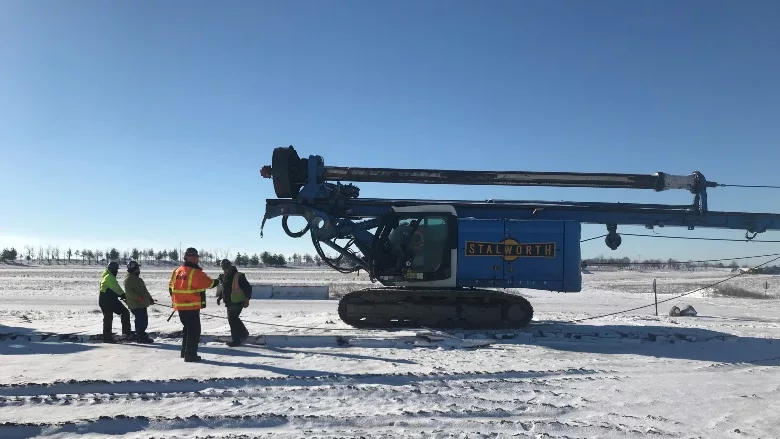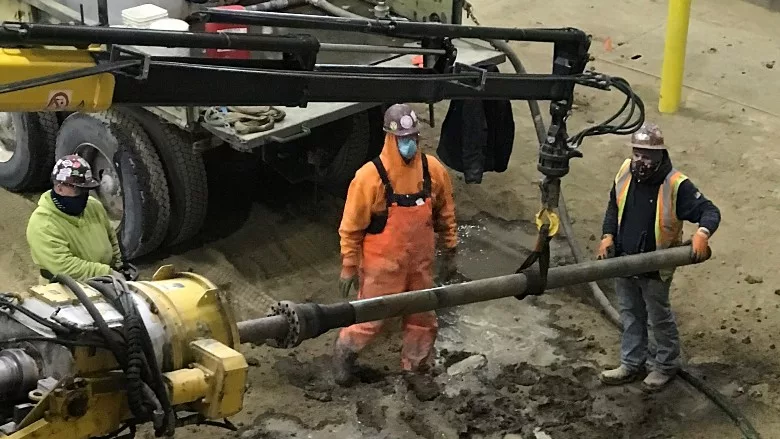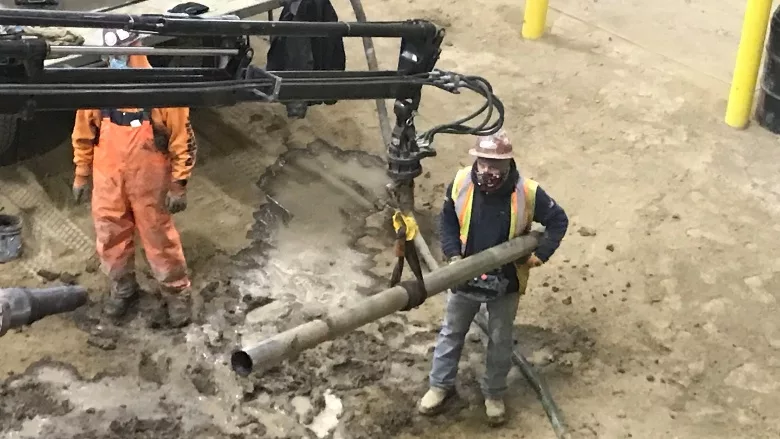Safety Factors for Multipurpose Drilling Rigs
Articulated Masts Add Flexibility, Specific Risks to Mitigate

The Apprentice and Skill Improvement Program conducts a training with a Soilmec SR-45 provided by Stalworth Underground.
Source: David Bowers

Multipurpose rigs like a Fraste Mito 60 can feature fully remote drilling operations, which comes with safety advantages even if it may seem a little foreign to some operators who depend on the “feel” to drill.
Source: David Bowers

As with any heavy equipment, columnist Dave Bowers says good site and task specific hazard analysis, crew training and frequent safety meetings are a must.
Source: David Bowers
This month I would like to talk foundation drilling safety, in particular micropile and tieback drilling safety. Micropile and tiebacks are commonly drilled using drill rigs capable of drilling in multiple positions from vertical to horizontal and 0 to 90 or even 120 degrees from the rig’s centerline. We commonly refer to these as “multipurpose” drills. This flexibility makes these types of drills extremely useful, but it also leads to some specific safety concerns.
Line of Sight
The first concern involves the possibility of drilling without a sight-line on the hands of your helper/oilers drill rod and casing connections. The control panels on most water well and geotech investigation drills sit directly next to the mast, so you can easily monitor your drilling assistant’s movements throughout the connection process. On many multipurpose rigs, if the mast is set up perpendicular to the centerline of the drill rig it becomes difficult for the driller to see the connection process. Clear communication between the driller and the drill crew becomes paramount in these types of situations.
Developing a standard operating procedure for each task, and training the drill crew in their specific responsibilities, is a must. I recently learned of a crew on a tieback job in which one crew member called off sick, and an apprentice working on a different part of the jobsite was reassigned to assist the tieback driller and helper in removing heavy-walled 12-inch casing. Due to a breakdown, the driller opeerated a different rig than normal.
After hoisting out a section of casing, the driller began to lower it rapidly while the two helpers tailed it onto horses. The horses had tabs welded onto the outer edges to keep tube stock from rolling off. The new crewmember, was stationed at the top of the casing. As he guided the casing onto the horse, his fingers caught between the tab and the casing, causing a crushing injury to his second and pinky fingers.
A root-cause analysis of the incident revealed that the driller’s unfamiliarity with the equipment, coupled with the new crewmember’s lack of understanding of his specific responsibilities on task-related hazards, led to the incident. Luckily, this incident was relatively minor. The worker wore gloves and suffered no amputation or permanent damage, but a simple pre-task meeting outlining the job and warning the new member of the potential hazards would have saved the company downtime and workers’ comp costs.
The hazards of a driller working in the blind are not limited to minor injuries. Poor communication could lead to unexpected rotation, up or down movement of the head or closing of a clamp. As in all types of drilling, these things could lead to severe injury or death. Establish clear verbal and hand signals prior to operation and review them with every member of the crew. Use the established Occupational Safety and Health Administration (OSHA) hand signals for cranes, forklifts or other types of equipment, or something specific to your company, as long as everyone gets trained and understands them. In OSHA regulations, these signals are considered “new signals” and are allowable, as long as the above training and comprehension are established.
Articulating Drill Masts and the Center of Gravity
Another hazard unique to multipurpose drill rigs derives from one of their key features: The mast articulates in so many different ways that the center of gravity moves dramatically up, down, left and right from the rig’s centerline. This is unique in drilling. Most drills have a known center of gravity with the mast up and head at the highest position. Most water well and geotechnical drills cannot raise the drill mast to a higher elevation while keeping it vertical, or turn it horizontally and run the drill head left to right. This dramatic movement of the center of gravity during operations makes the bearing capacity of the soil and the size of the blocking used underneath the stabilizers critical. These machines come with a much more complicated load chart than most drills. Following the manufacturer’s recommendations is a must to ensure drill rig stability.
This dramatic movement of the center of gravity during operations makes the bearing capacity of the soil and the size of the blocking used underneath the stabilizers critical. These machines come with a much more complicated load chart than most drills.
Many manufacturers of multipurpose drill rigs outfit their machines with a remote operation station to address the hazards of worker proximity during setup or a driller having to work in the blind. It may seem a little foreign to many drillers to lose the “feel” of the drill, but the advantages gained in safety and jobsite awareness greatly outweigh the negatives.
I recently had the pleasure of teaching a foundation drilling class with a multipurpose rig — a Fraste Mito 60 Sonic provided to our facility by Eijkelkamp North America, as well as a Soilmec SR-45 provided by Stalworth Underground, one of our signatory contractors. Both rigs incorporate radio remote control for tramming the rig onto and off of a lowboy, as well as around the jobsite. (Remote tramming is another safety discussion: Overturns while tramming consistently ranks high among incidents in foundation drilling.) The Mito 60 also incorporates a remote for all drilling procedures as well as for a knuckle-boom crane for tool handling. I was initially skeptical of using a remote control to drill until I ran this machine. During class, I also found students much less intimidated by the remote control than by the control panel, even though each have the same functions. This increased situational awareness allowed even students with limited experience to maintain clear communication and achieve a level of proficiency more easily.
Multipurpose drills have several unique hazards for operators. They also have the same hazards we encounter in water well and geotechnical drilling. These include, but are not limited to:
- Falls
- Caught-in-between
- Struck-by
- Heavy equipment awareness
- Contact with overhead or underground utilities
- Cave-ins
- Silica
- High-pressure fluid lines
- Dropped tools
In conclusion, regardless of the type of drill rig you run or type of drilling work you do, we work in a potentially dangerous profession. Good site and task specific hazard analysis, crew training, frequent safety meetings, and thorough, documented rig and tooling inspections are a must for the professional driller.
Until next time, stay safe and keep turning to the right.Looking for a reprint of this article?
From high-res PDFs to custom plaques, order your copy today!





